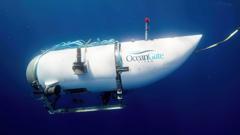The tragic fate of Oceangate's Titan submersible has taken a significant turn with newly released footage capturing the harrowing moment it imploded. This footage, obtained by the US Coast Guard (USCG) for their expansive investigation, offers a chilling glimpse into the moments leading up to the catastrophe. Recorded on the support vessel, the video features Wendy Rush, wife of Titan's CEO Stockton Rush, inquiring about a disturbing noise just before the submersible tragically lost its structural integrity.
The Titan embarked on its ill-fated dive to explore the Titanic wreck on June 18, 2023, carrying five individuals, including explorers and businessmen, who had each paid handsomely for the expedition. Despite being hailed for their adventurous offerings, deep-sea experts and some former employees had warned of potential dangers linked to Titan's design. Forewarnings about the carbon fibre structure—identified as a primary flaw—have resurfaced as critical points of concern in the ongoing inquiry.
In the newly released footage, Wendy Rush is seen reacting to an explosive sound 3,300 meters beneath the ocean surface, asking crew members what had happened. Initial text messages conveyed from Titan indicated a normal dive progression, but USCG findings show the sound was, in fact, the unmistakable noise of implosion. Tragically, all five passengers on board perished instantly.
This investigation has unveiled critical issues with the Titan sub. Analysis of data suggests that the carbon fibre used, a controversial material for such high-pressure explorations, began to undergo delamination during a prior dive a year before the fatal incident. Experts, including deep-sea pioneers, expressed grave doubts about Titan's safety, characterizing descents in the sub as risky undertakings.
The wreckage of Titan was later located on the ocean floor, marking the end of a series of exploratory journeys. The USCG plans to release a final report later this year detailing its findings while Oceangate has ceased its operations to cooperate fully with the investigation. The implications of this disaster are expected to resonate for years, with family members of those lost demanding accountability and legal recourse.
Christine Dawood, who lost her husband and son in the tragedy, emphasized the profound grief stemming from such loss, remarking that the experience has transformed her existence. As the investigation continues, it remains a poignant reminder of the risks associated with deep-sea exploration and the profound human cost of oversight in safety protocols.
The Titan embarked on its ill-fated dive to explore the Titanic wreck on June 18, 2023, carrying five individuals, including explorers and businessmen, who had each paid handsomely for the expedition. Despite being hailed for their adventurous offerings, deep-sea experts and some former employees had warned of potential dangers linked to Titan's design. Forewarnings about the carbon fibre structure—identified as a primary flaw—have resurfaced as critical points of concern in the ongoing inquiry.
In the newly released footage, Wendy Rush is seen reacting to an explosive sound 3,300 meters beneath the ocean surface, asking crew members what had happened. Initial text messages conveyed from Titan indicated a normal dive progression, but USCG findings show the sound was, in fact, the unmistakable noise of implosion. Tragically, all five passengers on board perished instantly.
This investigation has unveiled critical issues with the Titan sub. Analysis of data suggests that the carbon fibre used, a controversial material for such high-pressure explorations, began to undergo delamination during a prior dive a year before the fatal incident. Experts, including deep-sea pioneers, expressed grave doubts about Titan's safety, characterizing descents in the sub as risky undertakings.
The wreckage of Titan was later located on the ocean floor, marking the end of a series of exploratory journeys. The USCG plans to release a final report later this year detailing its findings while Oceangate has ceased its operations to cooperate fully with the investigation. The implications of this disaster are expected to resonate for years, with family members of those lost demanding accountability and legal recourse.
Christine Dawood, who lost her husband and son in the tragedy, emphasized the profound grief stemming from such loss, remarking that the experience has transformed her existence. As the investigation continues, it remains a poignant reminder of the risks associated with deep-sea exploration and the profound human cost of oversight in safety protocols.



















